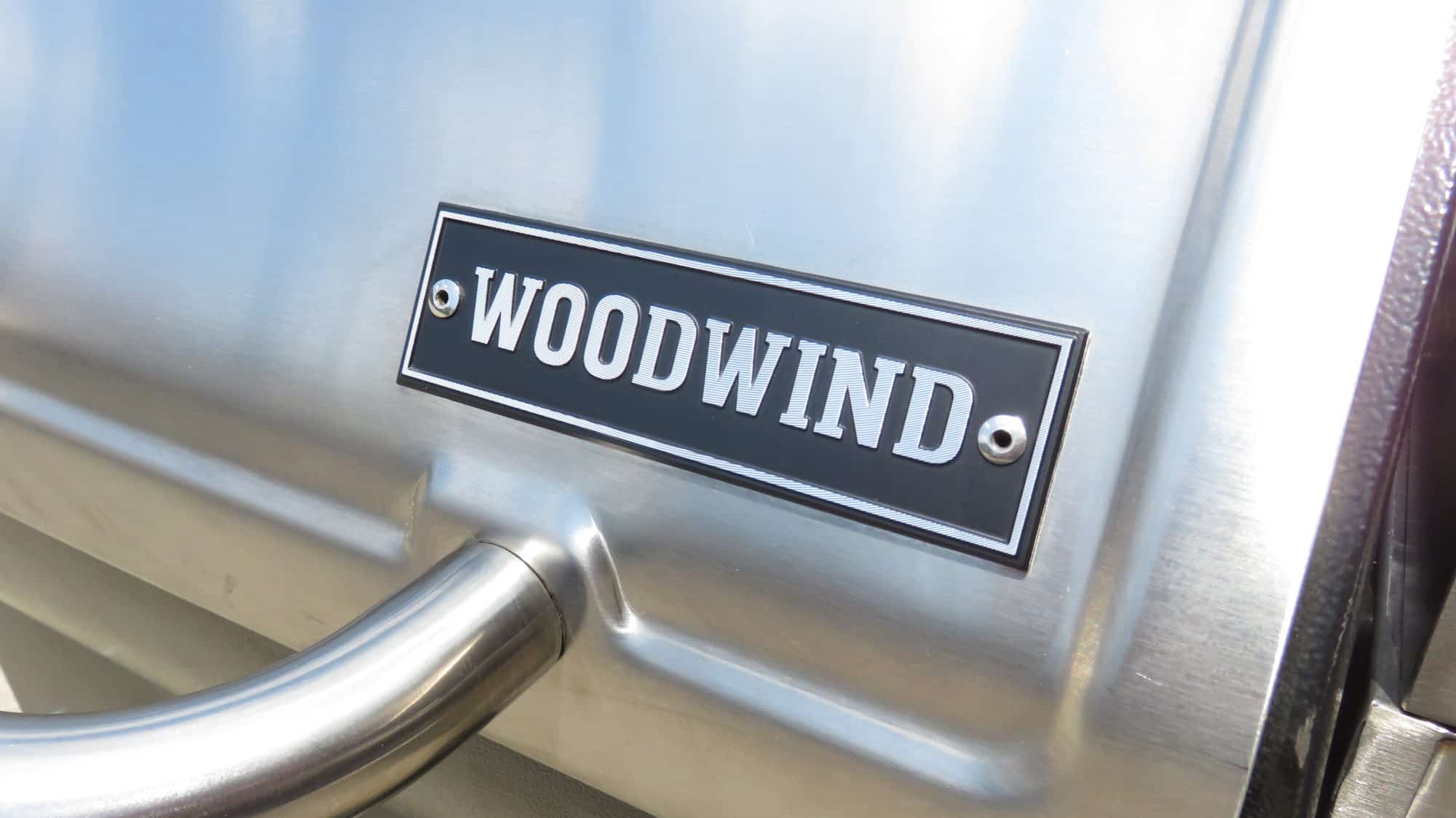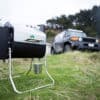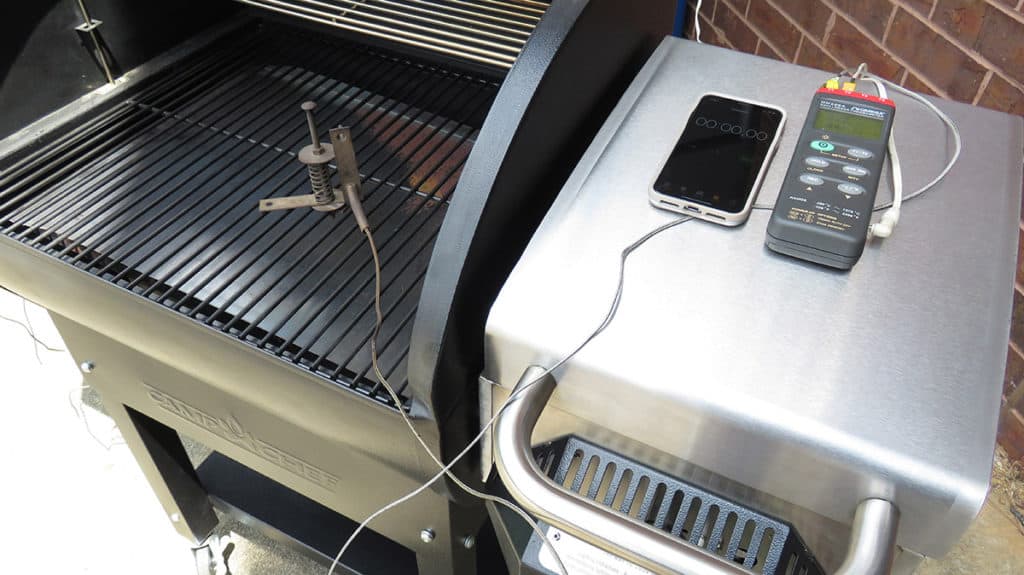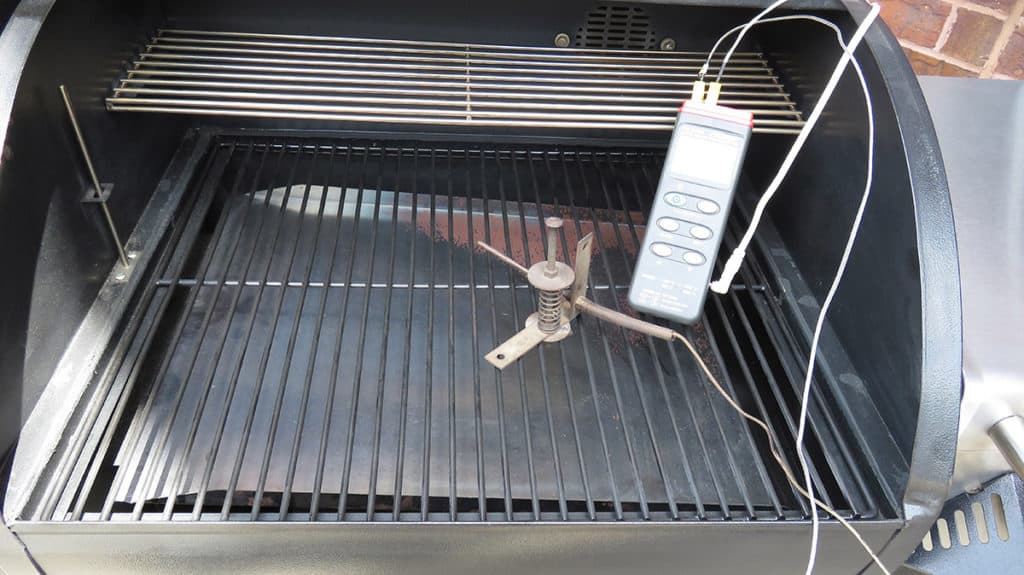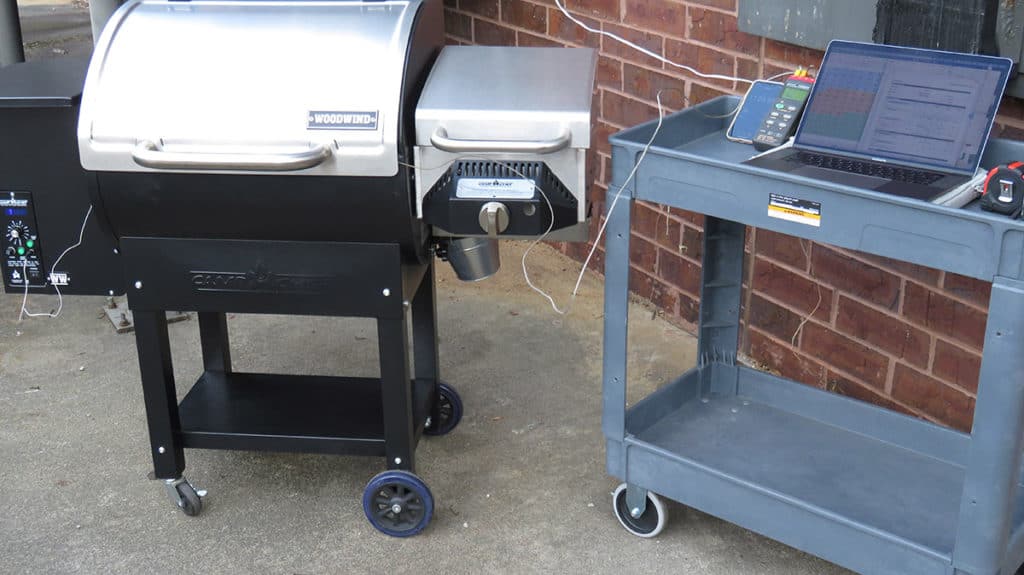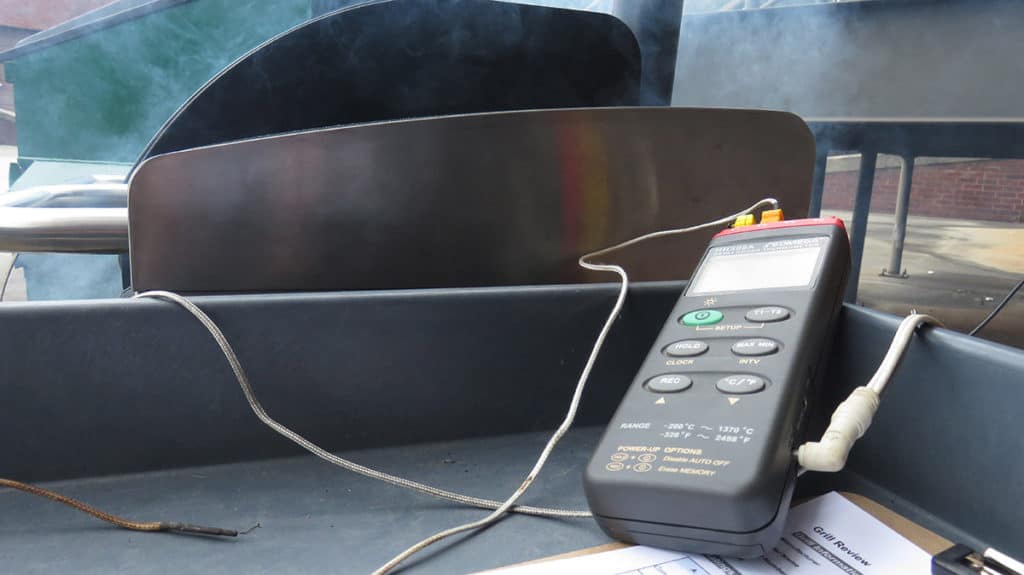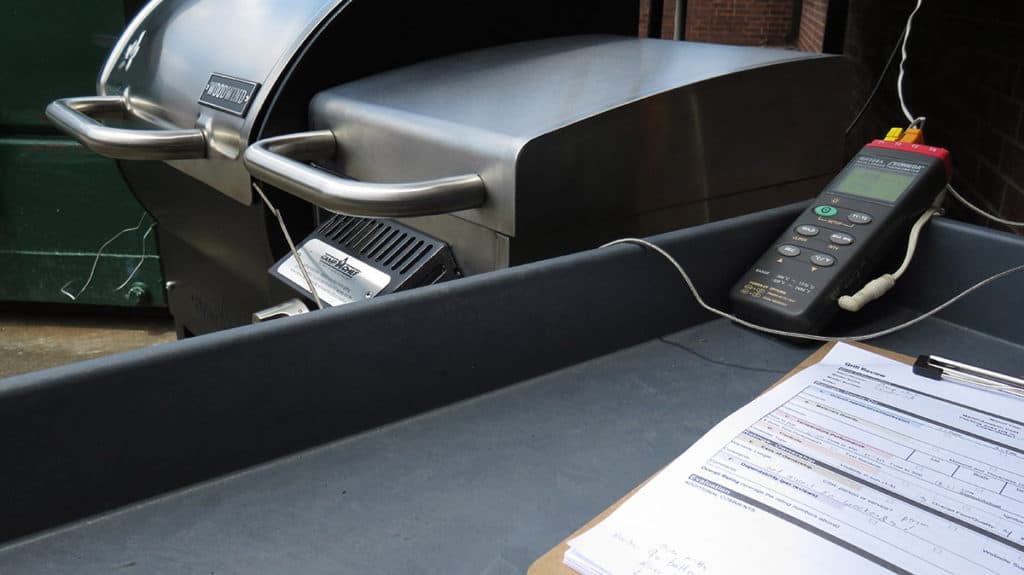Camp Chef has become a fairly popular pellet grill manufacturer and sells grills in the low- to medium-price range. The Woodwind is Camp Chef’s most versatile grill because of its medium size and available sidebox options.
Overview of Woodwind SG 24 Pellet Grill
Two of the available three models show how Camp Chef is attempting to address one weakness of pellet grills: that they aren’t grills at all, but rather smokers. The SG in this line stands for Slide & Grill Technology, which is Camp Chef’s method of sliding the heat deflector away from its position above the pellet firepot, so that more direct heat is possible.
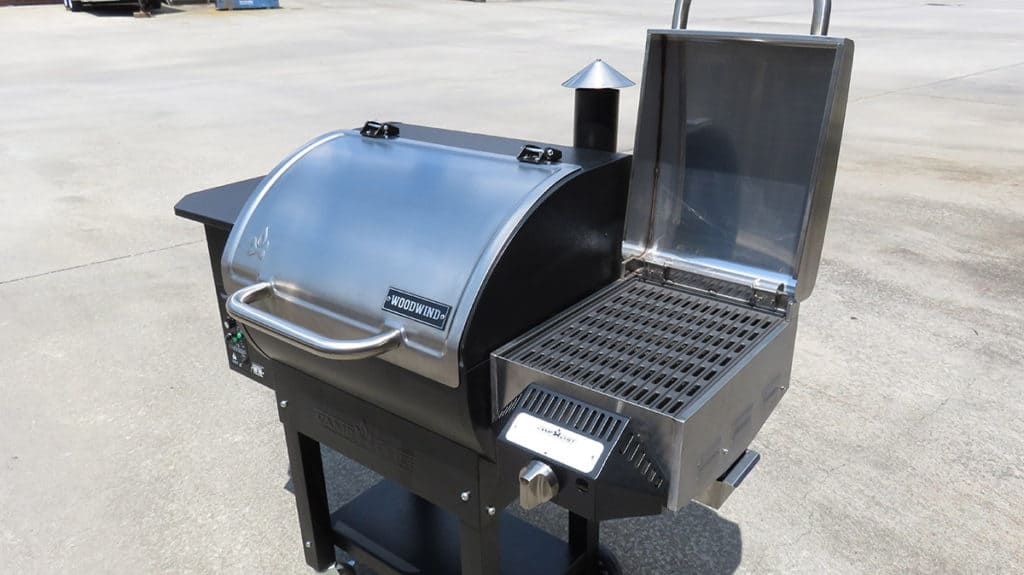
Two of the three available models in the Woodwind line are exactly the same at their core: the physical cooking chamber, the firepot, capacity, and controller. These two models are the Woodwind SG 24 with Sear Box ($900 MSRP,) and the Woodwind Classic 24 with Sidekick ($900 MSRP,) which offers a propane conventional mini grill instead of the searing box. You can assume that all but the searing box portion of our review applies to those additional two pellet grill models, as well.
Our test is on the Woodwind Classic 24 Pellet Grill, with the optional Sear Box, which has a propane-fueled side burner for searing purposes. In this configuration, it is, with a few minor differences, essentially the same as the SG 24 with Sear Box. We tested the Classic model ($700 MSRP,) but with the added optional Sear Box kit ($295 MSRP.) You may find an essentially identical prior-year model also available, the SmokePro DX, which is the same grill with a different name badge.
The notable differences in the Classic model and the other two SG 24 are that the SG adds:
- pellet viewing window to hopper
- Slide & Grill Technology (slides heat deflector for direct heat)
- bottle opener to pellet hopper
- third half-size grate for upper-level cooking
Camp Chef Woodwind Basic Features
Cooking Area
How we determine space: We give a max amount, based on packing items edge to edge on the grate. A pellet grill, however, has hot spots at the edges of the grate that aren’t over the drip pan. This means that at max food capacity, you’ll have to move/rotate food to prevent burning or overcooking. The effective capacity is the number of items that fit without having to rotate. In other words, it’s the capacity without being affected by the hotter edge zones of the grilling chamber.
We classify this as a medium-sized pellet grill, based on the size of its main cooking grate. Think four average-sized chickens, six if you pack them in tightly. You could easily cook two full racks of pork ribs flat (more with a rib rack,) and four average sized pork butts. It has 9” of height clearance—space for cooking a 12-13 lb turkey, and you could cook two at a time if thawed. Maximum space for 16 burgers, but effective capacity is 9 burgers.

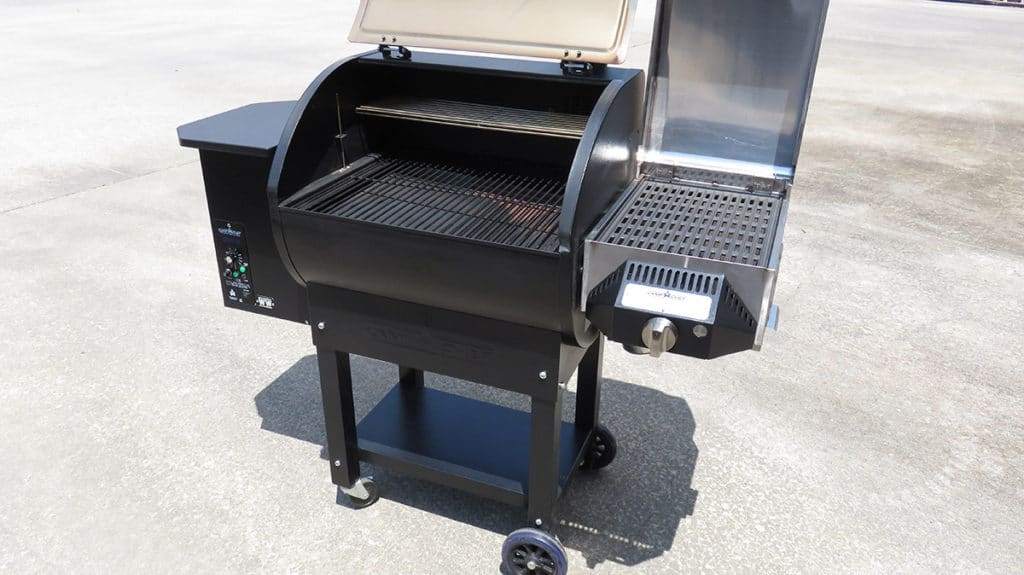
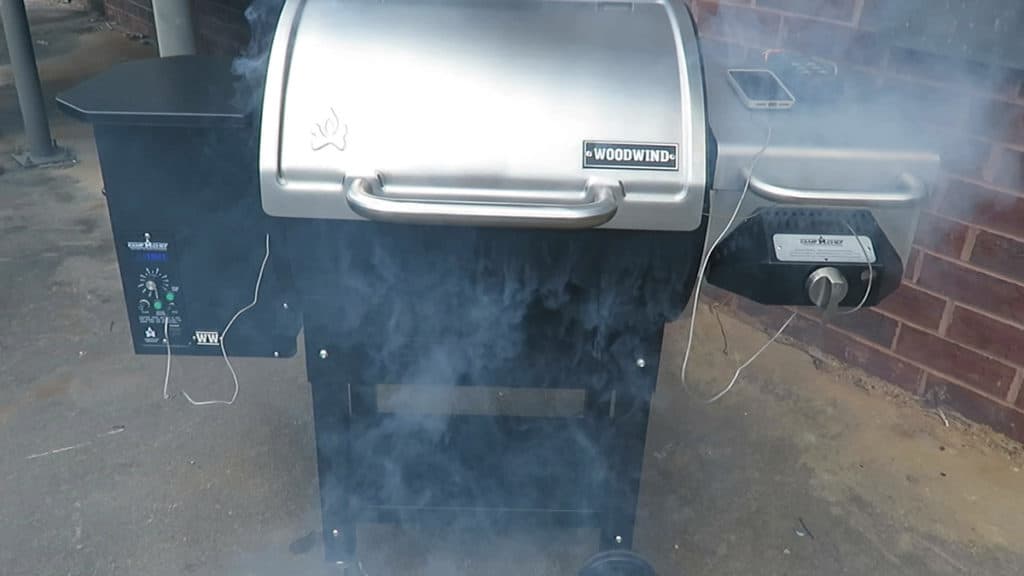
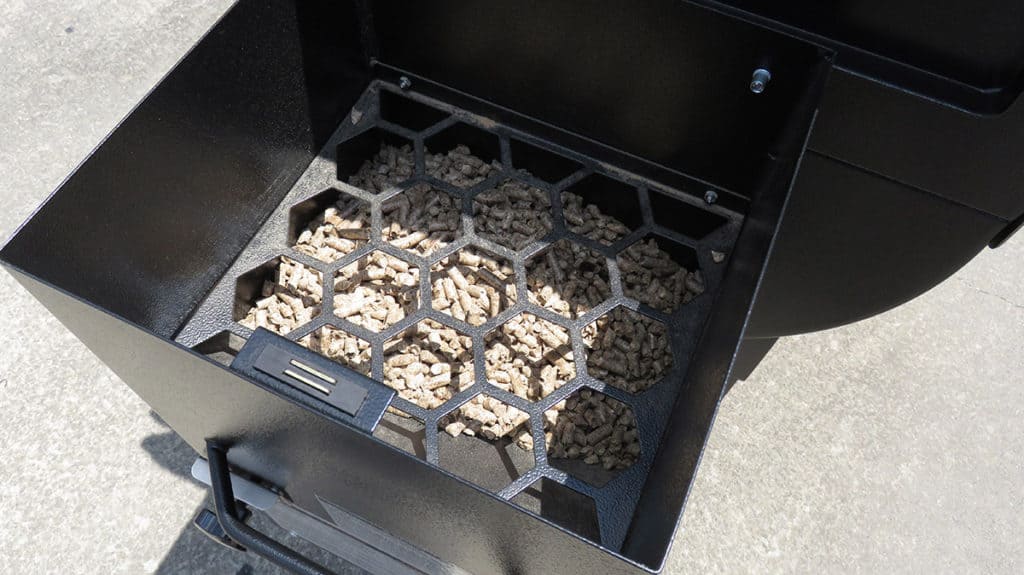
Pellet hopper 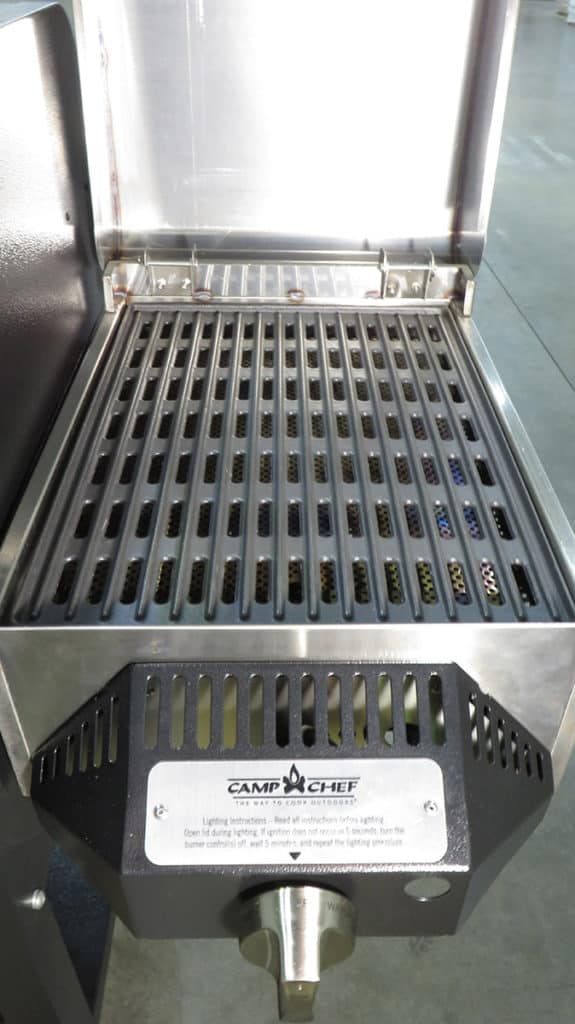
Side searing box 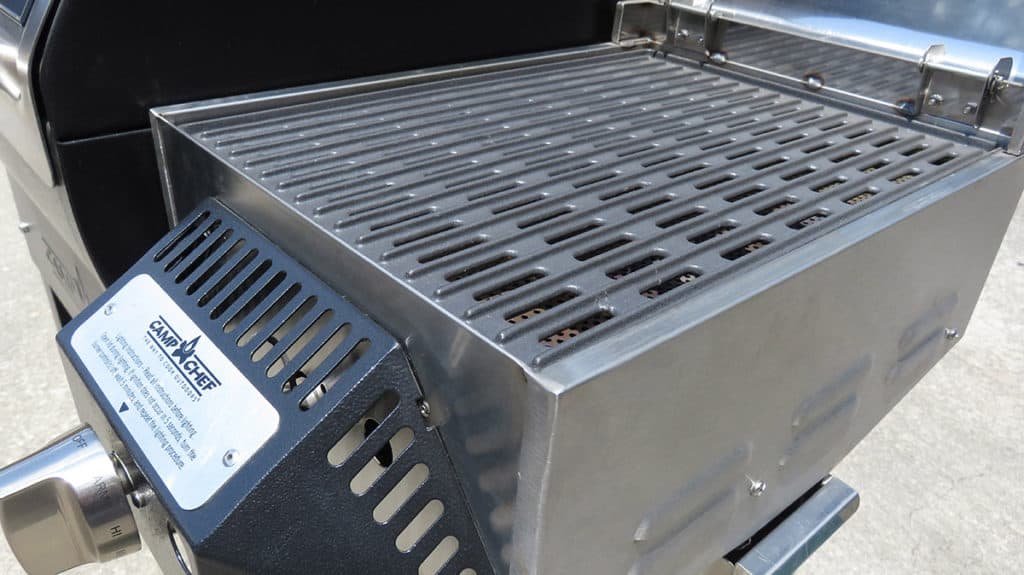
Side sear box
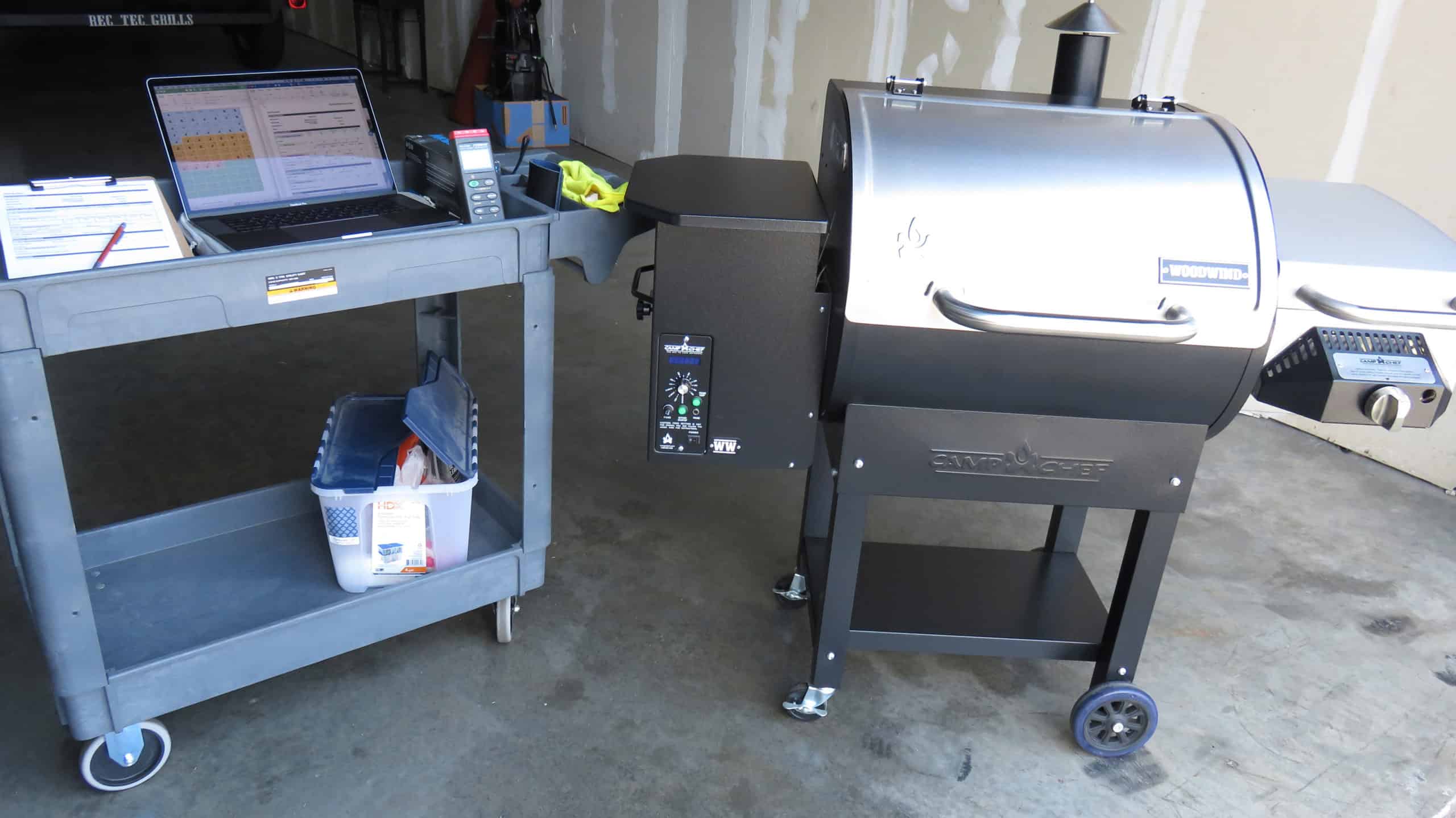
The Woodwind total cooking surface area comes in at 429 sq. in. for the lower grate (our measurements confirm this at 19.5” x 22”.) The half upper grate on the Classic ads 144 sq. in., bringing the total cooking surface area to 570 sq. in. The Sear Box and Sidekick models add a second upper-level grate to bring the total to 811 sq. in. The lower grate is enameled steel and the upper grates are nickel-plated.
Controller Type
All models use a conventional controller, rather than the more advanced PID controller technology. Essentially, this means that it controls the temperature by changing the speed at which pellets are fed into the firepot, combined with two fans controlling airflow into the combustion process. Temperature inside the cooking chamber is monitored and the grill’s controller automatically changes the feed rate and the on-off state of the fans in order to maintain this target temperature.
The Woodwind controller has an analog dial temperature and mode selector, and a digital readout for actual temperatures.
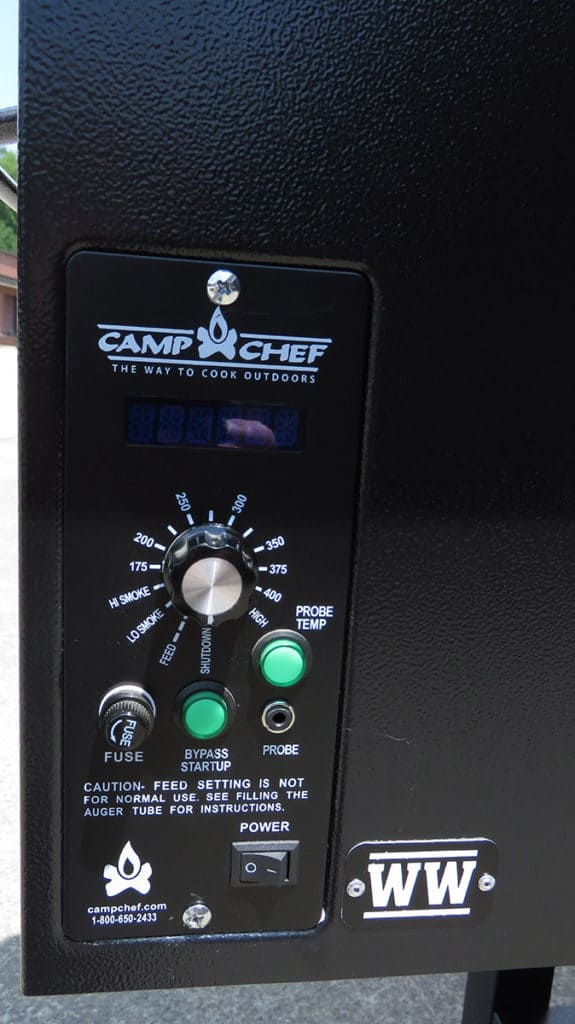
The controller has a Low Smoke mode, a High Smoke mode, and claims a temperature range from 160 to 500 F. There is a built-in food temperature probe input for the included food probe. The display of the grill temperature and the food probe temperature are toggled with a “Probe Temp” button on the controller.
Notable Features and Conveniences
- Pellet Cleanout chute in pellet hopper: change or empty pellets between cooks
- Ash Cleanout: no need to remove grates, drip tray, and heat deflector in order to clean ash from firepot
- Smaller upper grate(s) for additional smoking/cooking capacity
- Available side searing box or mini grill for additional cooking flexibility
- Four wheels
Manufacturer Specs
- Upper Rack Area: 382 sq. in.
- Lower Rack Area: 429 sq. in.
- Total Rack Surface Area: 811 sq. in.
- Chamber Capacity: 4,850 cubic in.
- Hopper Capacity: 22 lbs. of pellets
- Overall Height: 42 in.
- Overall Weight: 150 lbs.
- Warranty: 3 years
Camp Chef Woodwind Hands-On Review
We tested a fully assembled grill in our offices, using our standard testing protocols. Our final summary ratings appear at the end of this review.
Overall Appearance/Impressions
Overall, the Woodwind is an attractive, fairly compact grill. It uses brushed stainless steel on the lid only (and on the optional Sear Box.) The remainder of the grill is black painted steel. The grill has a feel similar to a box-store bought gas grill in quality: it’s sturdy and decent, but the steel throughout is on the thinner side. The Woodwind smoker definitely doesn’t come across as hefty or solid as other more expensive grills.
The barrel of the smoker is flat on the back, barrel-shaped in the front. This allows for a slightly larger front opening, which is useful for inserting and removing larger items like turkeys or pork butts. It also allows the smokestack vent to be placed on the flat rear surface, which leaves the side open to a side-shelf (on the Classic) or the optional Sear Box or Side Grill (on those models.)
The ability to sear a steak or burger on the sear box is a definite plus for this grill. It’s common knowledge that a pellet smoker will cook your meat well and with a great flavor, but if you like a crust or grill marks on your chops or steak, it just won’t really do that. The available sear box solves that issue.
One very noticeable feature missing on this grill is the ability to control it via wi-fi. There are other pellet grills in this price range with the ability to turn on, control temperature, and monitor food temperatures, all remotely through an app on your mobile device. While it’s not a vital feature, it is certainly a huge convenience to have, and it’s one that is available at this price range.
Materials Quality
As stated before, the materials are fine, but definitely are not top-quality. The lid is 430 stainless steel (see our article for our review of stainless steel types in pellet grills) and is of average thickness at around 2mm. The grill body, like the legs and bottom shelf, are painted 1.5mm thick carbon steel, rather than stainless. This is on the slightly thin side when compared to other similarly sized grills, but very similar to other similarly priced grills in this class.
The main components of the cooking chamber are, likewise, on the thin side for the segment, and are made of carbon steel rather than stainless. The firepot is stainless. The grates are enameled steel and are 5mm thick, which is average. Stainless steel is something you see here on other grills and long-term durability and corrosion will definitely be a concern. If you own this grill, it’s imperative that you keep it covered and maintain it well in order to avoid corrosion. Also of note is that the ignitor rod is stainless, rather than the much more durable ceramic type. Know that a stainless ignitor rod could fail, depending upon environment and other conditions, within a year or two, whereas a ceramic ignitor rod has an almost lifetime length of use.
Woodwind Construction Materials Details
- Lid: 1.8mm Stainless
- Body/walls: 1.5 mm steel
- Grate: 4.86mm enameled steel
- Drip pan: 1.25mm steel
- Heat Deflector: 2mm steel
- Firepot: 316 Stainless
- Ignitor Rod: Stainless
In use, there was a notable buzzing of metal coming from the grill and the sear box assembly. This was partially due to vibrations of the thinner materials from the running of the fan, and possibly due to the fan in the controller box vibrating against a loose part or wire. There was a near-constant rattling sound from the hopper/auger area of our grill during our test, probably from the same overall materials quality issue. The thin material in the handle also became an issue at high temperature tests as we measured an uncomfortable 170• temp on the surface of the handle.
Overall, we rate the Camp Chef Woodwind as average materials and construction quality.
Grill Operations and Controls
The Woodwind has 13 heat settings, from 175-400, in 25 increments, plus a “High” setting which the manual states will get temps up to 500. All of these temps are selectable via a rotary dial. There is also a low-smoke and hi-smoke mode, which had temps of about 170 and 205 in our tests. The smoke settings differ from “normal” temp selections in that the auger feeds the pellet differently so that they smolder rather than burn.
There are two additional selections on the controller dial: “Feed” and “Shutdown.” The shutdown procedure isn’t automatic as with some other pellet grills. You must choose the “Shutdown” mode and let it complete before powering off the smoker. The “Feed” setting is for initial startup only and ensures that the auger tube is full of pellets before ignition. You shouldn’t need it in day-to-day operation.
There are two green buttons on the controller: “Bypass Shutdown” and “Probe Temp.” The Bypass Shutdown function is used if the grill has lost power or been turned off and you need to restart it while still hot. In other words, it skips the “fill the auger tube with pellets” portion of the startup procedure. The Probe Temp button toggles the digital display between grill temperature and probe temperature.
The digital readout displays various mode or status codes as well as current temperature of either the grill or the one temperature probe. The blue LED display is bright and large and readable, though it can be hard to read in direct or bright sunlight without shading the area with your hand.
The controls are straightforward and simple to operate. We have a few issues with the capabilities of the controller, none of which are major: The startup and shutdown procedures are not “push one button” simple and require additional extra steps compared to other grills in this class. A PID controller is more desirable, as it allows for more accurate and responsive temperature control, but this controller will be sufficient for the average cook. We would also prefer to see two temperature probes rather than just one. And we’ve already discussed the benefits you’ll miss out on by not having wi-fi control capabilities.
Temperature Performance
Our temperature tests are important because the two critical components in smoking delicious food are time and temperature. The ability to accurately control temperature and cook time, combined with wood smoke, is what makes your food taste amazing and also makes the pellet smoker such a revolutionary backyard grill. Accuracy in temperatures, then, is vital for a successful cook and in a quality pellet smoker.

You can read more about our testing procedures, but to summarize, we use industrial laboratory grade temperature probes and data logging on multiple surface points in the smoker to record several categories of data:
- Time to reach a set temperature
- Accuracy of temperature readings (for both probe and grill controller)
- Consistency of temperature readings (swings in temps)
- Actual high and low temperatures of the grill
- Smoke produced (subjective, not measurable)
Temperature Performance Summary
Overall, we found the Woodwind to be accurate to within 20-30 degrees, with actual temperatures usually lower than what the controller on the smoker reads. Fortunately, this was consistent throughout the temperature ranges and so if we were to cook on this grill we could make the necessary settings adjustments by setting the grill temp 25 degrees higher than the intended temperature. While it’s always a good idea to use a separate temperature gauge to know how accurate your grill’s temperature is, due to this inaccuracy, we highly suggest you do it with the Woodwind. The Woodwind’s included temperature probe was very accurate compared to our temperature data logger.
| Setting | Time to Reach | Our Measured Temp | Grill Controller Says | Grill Probe Says |
| Low Smoke | 5:10 | 165 | Low Smoke | Not avail |
| 200 | 6:40 | 189 | 200 | Not avail |
| 325 | 8:00 | 302 | 330 | 331 |
| 350 | 11:30 | 320 | 350 | 374 |
| 400 | 15:30 | 390 | 400 | 400 |
| High | 18:21 | 508 | 502 | 510 |
As for smoke production, we found the Woodwind to produce adequate amounts of smoke, especially at 225 and lower temperatures. One note is that we saw poor drafting and sealing in the smoking chamber that was evident in large amounts of smoke pouring from the front lid (see video.) We also noticed that the grill “flamed out” and had to restart its fire several times around the 225 mark, which produced large amounts of smoldering smoke when the pellets reignited.
Pellet grills aren’t meant to be scientifically precise in their temperatures, but they should be predictable and consistent and accurate within 10% or so. The Woodwind was a little outside of this range, especially at lower temps, and had some trouble maintaining a consistent fire. This latter issue is likely due to its lack of a PID controller. It’s not a fatal flaw and would probably escape the notice of most owners. It is an issue, however.
Camp Chef Woodwind Ownership Experience
Pellet smokers are largely maintenance-free, other than routine cleaning. But there are some complex components that have been known to fail, and there are some parts that need periodic replacement, like the ignitor rod. Because of this, we like to do a review of manufacturer warranties, as well as common issues that a model might have.
The Camp Chef Woodwind, and all Camp Chef pellet grills, has a 3-year warranty. As well, they have a toll-free customer service number for service issues or product support questions.
Customer Service
We called with a simple question on a Friday afternoon about 2pm ET. When we called, there was an automated call tree service and we were on hold a total of only 1 minute, which is a plus. The customer service person that answered seemed overall helpful but didn’t seem super knowledgeable about pellet grills in general. We asked about the 25-30 degree temperature difference we were seeing. She asked what kind of pellets we were using (a very valid question) and we assured her we were using a premium pellet, Cookin Pellets, which she had never heard of. That isn’t awful, but it’s not a great sign. In the end, her advice was to check out the large Facebook community for Camp Chef smokers and that someone there would probably be able to help. Not a great response.
One other issue we have with their customer service besides its generic knowledge is the availability. They’re only available until 5:30 MT Monday through Friday. So if you’re having a Friday night or a weekend cookout and run into an issue, you won’t be able to call Camp Chef for assistance.
Ease of Ownership
The online presence of the Camp Chef community is quite large. The Smoker Smokers group on Facebook, for instance, has over 13,000 members. As you can imagine, you can probably find plenty of helpful tips, recipes, as well as service and maintenance tales in this or several other Camp Chef sections of online forums.
The Camp Chef website has a fairly extensive blog, though it covers the complete line of Camp Chef products, not just their pellet grills. The same goes for their online recipes, videos and their social media accounts: there’s plenty of information there, but you’ll find info on cast iron cookware and propane camp stoves mixed in that you’ll have to sift through.
Dependability
We look to online forums as well as manufacturer Frequently Asked Questions in order to try and find the most common issues with a particular model. For the Woodwind, we found the following:
- Reports of flameout at low temperatures (solved by raising the chimney cap)
- Probe quality and reliability seems to be an issue (replaced under warranty or people bought 3rd party replacements)
- Noisy and even failing auger motors (replaced under warranty)
Obviously, we aren’t saying the above are known defects, just that they’re the more common issues we found.
Camp Chef Woodwind Overall Rating
The Woodwind is a fairly popular pellet grill, and for understandable reasons. It is of average quality, from a reputable, if very large, company, and at a good price. We think that better quality can be had for the same price range, so we wouldn’t call it the most economical choice. It is, however, a solid choice for people who think they’ll use their smoker only occasionally or want to try one out and don’t want to make a large investment.
We like the side box options available on the Woodwind and the flexibility thet it provides. We’d love to see a higher-quality grill utilize the same sort of options. But as for the Woodwind, it’s a good choice for the entry-level cook who also wants the ability to sear or grill.

